Symbols for death have been around since symbols were first recorded. From Ancient Rome and Greece to Africa and China, different symbols have come to be used when someone has died.
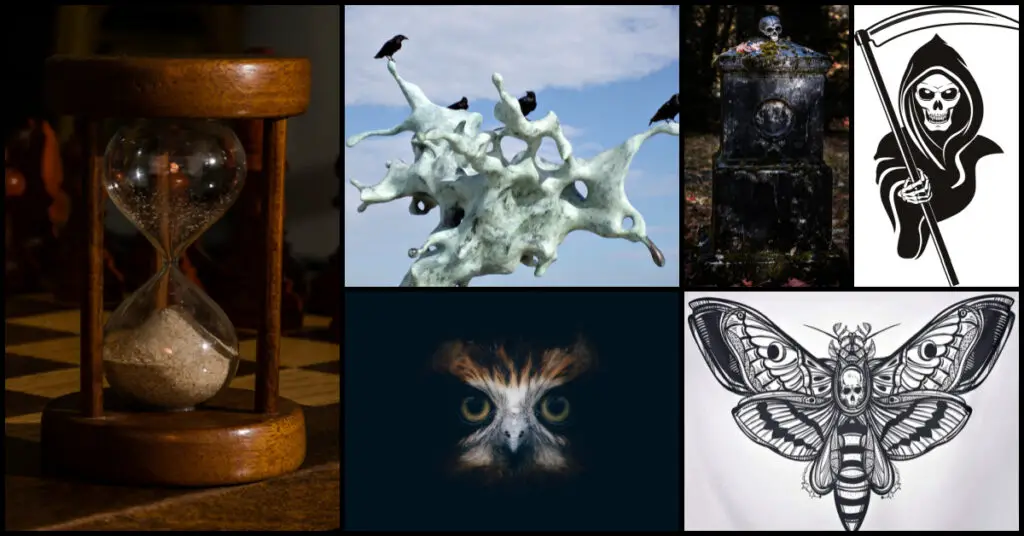
La Catrina Symbol
Symbol of death, protection
In Mexico, the symbol La Catrina is found on the Day of the Dead. La Catrina is a skeletal figure adorned in a glamorous dress with a wide-brimmed hat. La Catrina is a descendant of the Aztec goddess Mictecacihuatl who was the goddess of death. La Catrina is a symbol of death but she is also the guarding of those who have died. She was created with a fancy hat to remind people that no matter what their background, whether poor or rich, they would all die someday.
Death’s Head Hawkmoth Symbol
Symbol of death, blindness, pestilence, war, souls
The Death’s Head Hawkmoth has a skull shape on its back. This moth is considered a symbol of death. The Death’s Head moth depicts death in the family in Celtic mythology. It was also believed that this moth would foretell pestilence and war. In Wales, the Death’s Head moth was thought to cause blindness if any part of it touched a human being. In Scotland and Ireland, the Death’s Head moth in a home symbolized imminent death. In Native American culture, the Death’s Head moth symbolizes the souls of the dead. The species of the Death’s Head Moth were named after the River Styx, the border between our world and the underworld, and Acheron, the River of Pain. The species Lachesis was named after the Indian fate which measures life and the Atropos was named after the fate that cuts the thread of life.
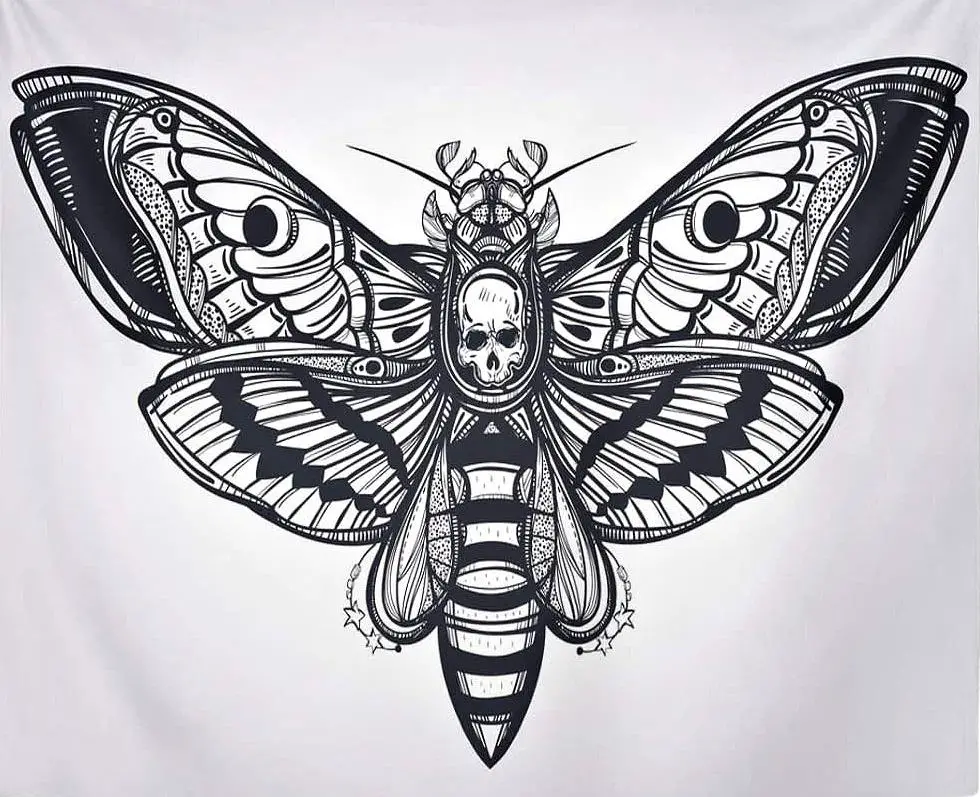
Thanatos Symbol
Symbol of death.
The Greek letter Theta and the poppy are the symbols for Thanatos the personification of death in Ancient Greece. Thanatos was the twin brother of Hypnos and was hated by everyone, including the other gods. He carried out his orders and took people to the underworld as their time came. He did not make them suffer, though. Sometimes people were capable of evading Thanatos. Alkestis had given her soul so her husband could live. Thanatos went to collect her souls but Hercules was at the house at the time. Hercules beat Thanatos in battle and won Alkestis her soul. Thanatos had to return to the underworld defeated. When Sisyphus was to die, Thanatos went to retrieve him. Sisyphus tricked Thanatos and he ended up in the chains meant for Sisyphus. While Thanatos was tied up no mortal could die. He was imprisoned until the god of war, Ares, rescued him. Ares had grown tired of people not dying in battle, so he freed Thanatos. In modern times, Thanos from the Marvel movies is a modern personification of Thanatos. In the movie, Thanos wants to cut the population in half. He does not discriminate against rich or poor, young or old, healthy or sick people. He states that their death will be swift and painless.
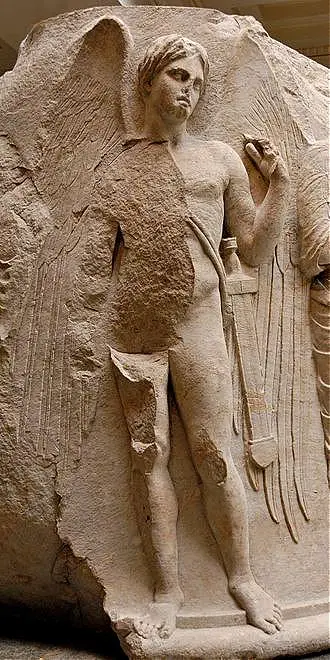
Owuo Atwedee Symbol
Symbol of death, transition
The Owuo Atwede symbol comes from the Asante peoples of West Africa. This ladder symbol represents the mortality of man and the ascension into the next realm. The symbol was printed on clothing worn for funerals. The clothing would hold different symbols representing the person’s life along with the Owuo Atwedee symbol. It is a symbol to remind people to be good in this world so they are worthy of the afterlife.
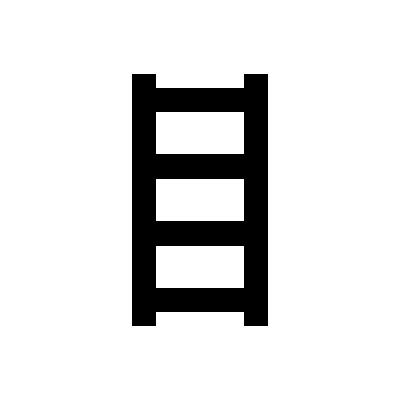
Skull and Bones Symbol
Symbol of death, destruction, victory, and power.
The skull and bones symbol originated in the Aztec Empire. The skull and bones symbol was carved onto tombs. In Ancient Greece, a skull and crossed scepters were found on ancient altars. After the 13th century, the skull and bones became a symbol for pirates and looting. In Northern Europe, the skull and crossbones first symbolized memento mori and were depicted on wall hangings and rosaries. Later the meaning changed to victory over death in honor of the resurrection of Christ. Many armed forces including the Marine Corps and certain divisions of the British Army and Royal Navy have depicted the skull and crossbones on their uniforms to symbolize power.

Mummy Symbol
Symbol of death, transformation, reincarnation
Although Egyptian mummies are the best known, there were also mummies in several other dry areas including North and South American desert areas. Mummies are bodies that were preserved and wrapped after death. The belief is that people will maintain their corporal sense in the afterlife, so their bodies must be preserved in this one. Mummies symbolize both death and transformation to the afterlife. In modern times, mummies have been depicted as coming back to life after dying.
Owl Symbol
Symbol of death, messengers, revenge,
In Native American culture, the owl is considered a symbol of death. Owls are sometimes considered evil omens or messengers from another realm. In the Aztec culture, owls were considered messengers of the gods of death. In the Navajo culture, it was believed that an owl would speak a person’s name and that person would die. In the Welsh tradition, there was a woman made from flowers named Blodeuwedd whose husband turned her into an owl after she tried to kill him. He transformed her as such so the other birds would shun her and she would never see the afternoon light again. She was forced to live out her life as an owl. The Viking culture associated owls with the death of a neighbor.

Raven Symbol
Symbol of death, mediation
Vikings considered ravens symbols of death. If ravens gathered above an army, they would be defeated. Witches would transform themselves into ravens in order to perform evil deeds. Ravens were the eyes of the gods in the world and people saw them as omens of death and in league with dark powers. Ravens are considered the ghosts of murdered people who did not get a decent burial, according to Swedish folklore. In Serbian tradition, the raven symbolizes death. Because the raven is a carrion bird, it is believed to be a mediator between worlds.

Gravestone Symbol
Symbols of death, commemoration
Gravestones were used as far back as the ancient Roman and Celtic traditions. Ancient Celtic burial mounds had a gravestone to mark the area. Their ancient gravestones depicted Celtic warriors, crosses, and twin Janus-looking figures. These stones marked the area where there were graves, as opposed to individual gravestones. In Ancient Rome around the 1st century BC, there are individual gravestones marking the spot where military figures are buried. On these gravestones, there are figures, epitaphs, and other iconography. Individual, lasting gravestones were built starting in the 1600s. Before this, individual gravestones may have existed, but they were most likely made out of wood. Gravestones have marked the place where people have died for a long time. There are myths associated with gravestones such as not standing on a horizontal stone or a person can be drug inside the grave. As gravestones mark where people have died, they play a prominent role in horror movies in modern times. Scenes of a fog-covered cemetery or a hand reaching out below the gravestone symbolize the terror associated with death and the unknown of the afterlife.
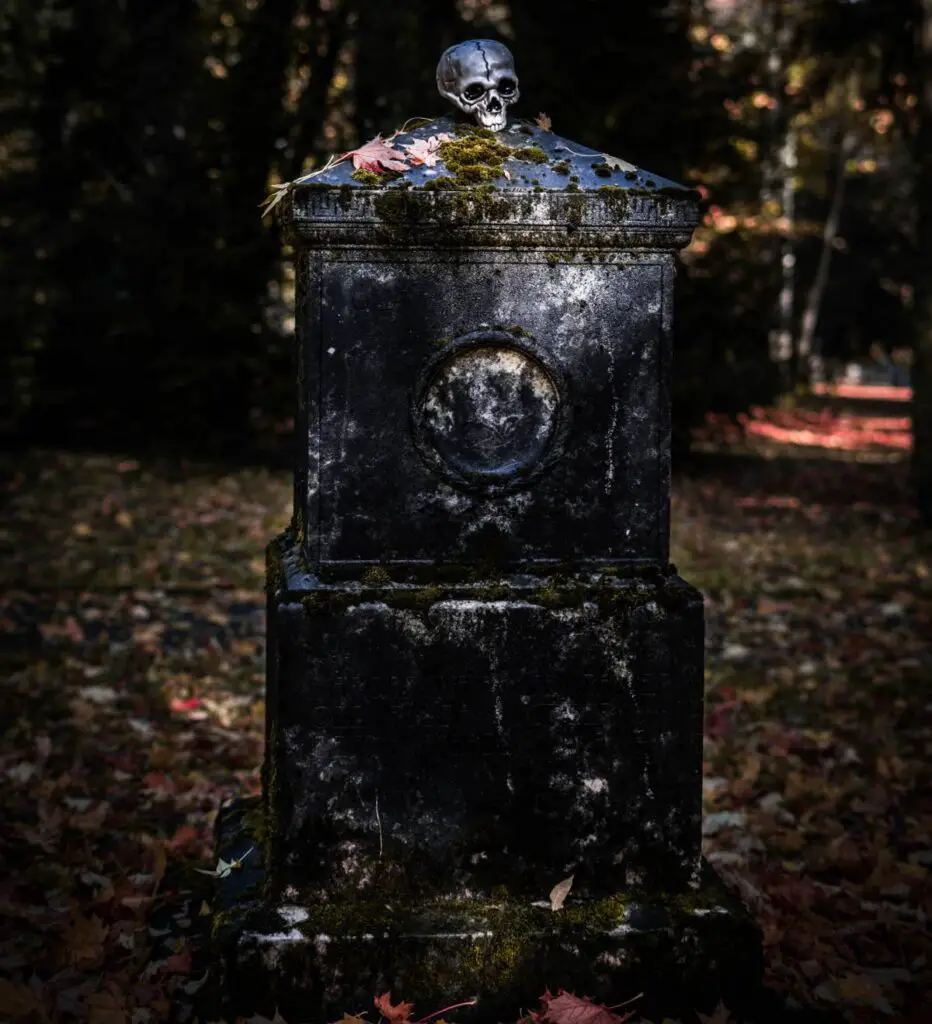
Grim Reaper Symbol
Symbol of death, dark powers, Devil
Throughout Europe, the Grim Reaper is a symbol of death personified. In most of these cultures, the Grim Reaper is portrayed as a skeleton carrying a scythe in one hand and sometimes an hourglass in the other. The scythe symbolizes a life cut down. The skeleton is sometimes wearing a cape, but not always. The Grim Reaper symbol evolved from a skeletal being in the Netherlands who was a skeleton and referred to as the mow-man. During the Middle Ages, this figure was more Christianized and the robe and scythe were added. The figure was used in the Danse Macabre era of artwork prominent during the Middle Ages. This artwork signifies that everyone dies, no matter what their status. In Smyrna, Billhook or Death are the names that the Grim Reaper is known by. The Grim Reaper symbolizes dark powers and the Devil. Scandinavians had Hel, the goddess of death, but then took on the Grim Reaper. In modern times, the Grim Reaper is most famously portrayed in the movie The Seventh Seal, by Ingmar Bergman. The Grim Reaper has also appeared on book covers and albums throughout modern times.
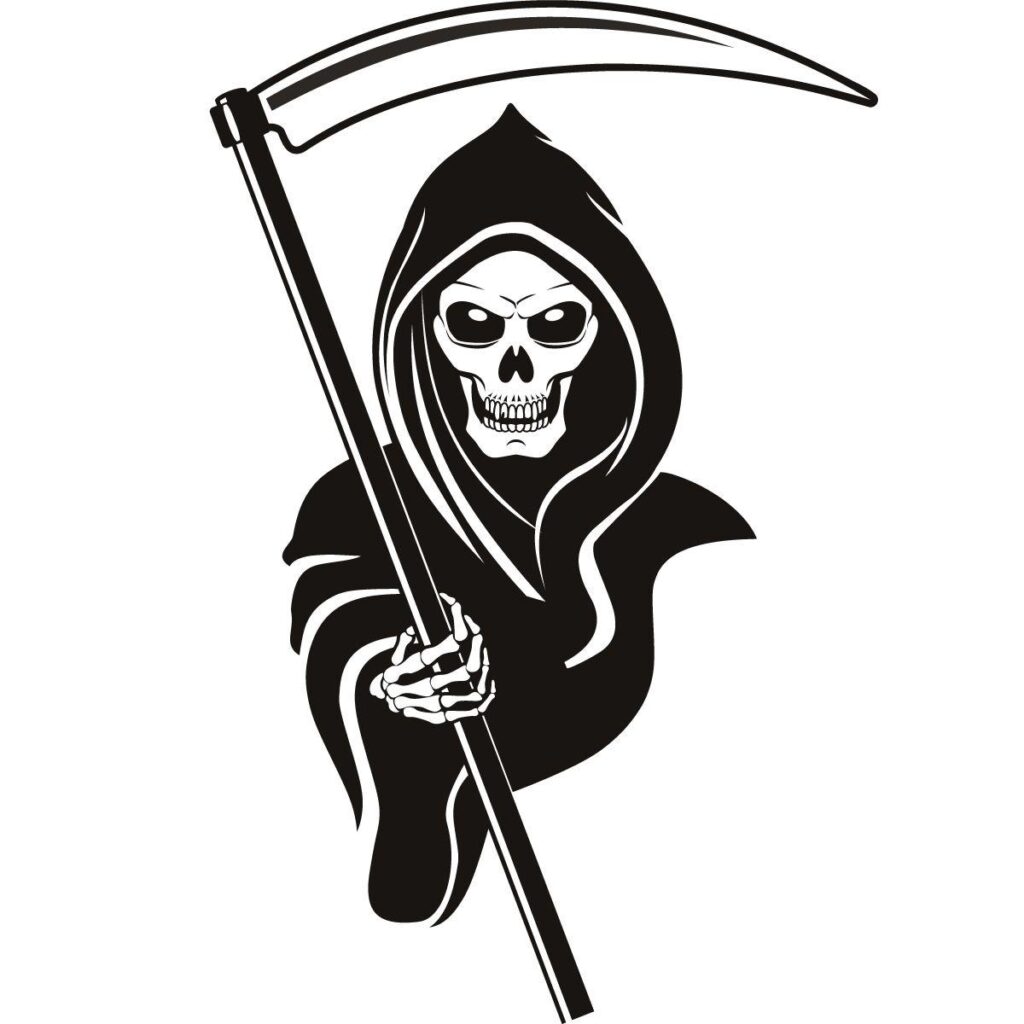
Hourglass Symbol
Symbol of death, time
The hourglass was developed around the Early Middle Ages in Europe. It was developed to help people tell time. When the sand ran out of one end, an hour had passed. The hourglass could then be flipped to count another hour. Hourglasses were used to measure the time until the mechanical clock was developed. The hourglass symbol is composed of two triangles, one upside down on top of the other. These triangles represent nature. The lower represents the Earth and the upper represents the sky. The hourglass symbolizes death in that it measures the time of life a person has left. Some hourglasses have wings on them to represent fleeting time. Hourglasses have been carved onto tombstones and placed in coffins. Hourglasses have also been placed on gravestones. Pirate ships would fly a flag with an hourglass insignia symbolizing the time their victims had left to live.

Citipati Symbol
Symbol of death, protection, eternal change.
The Citipati symbol comes from Buddhism. The symbol consists of a female and male skeleton dancing. The skeletons symbolize eternal change and death. The Citipati were monks who were deep in meditation. While they were in this state, a thief came and cut off their heads. The monks transformed into the final state and pursued the thief, even in death. The Citipati now watch over graveyards and capture thieves who stray among the graves. Tibetian monks will dance and blow horns in graveyards to demonstrate how the Citipati pass their time. The Citipati are sometimes called the Lords of the Cemetery.
